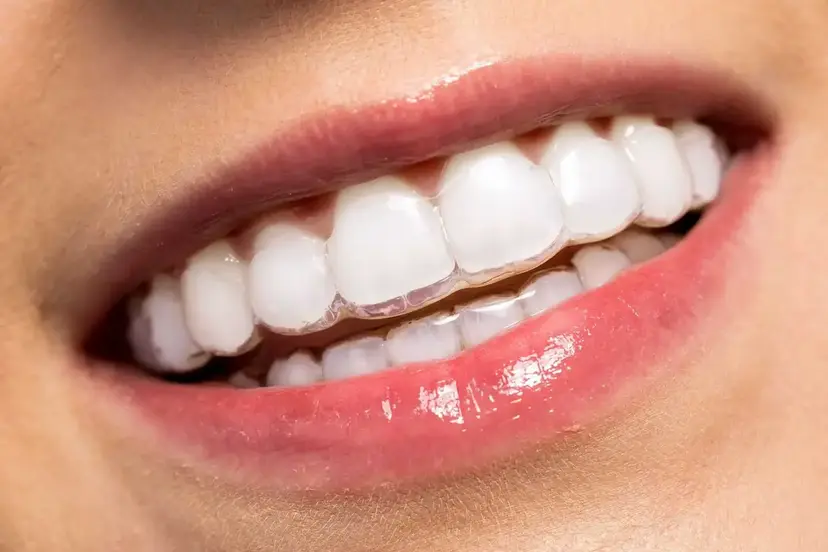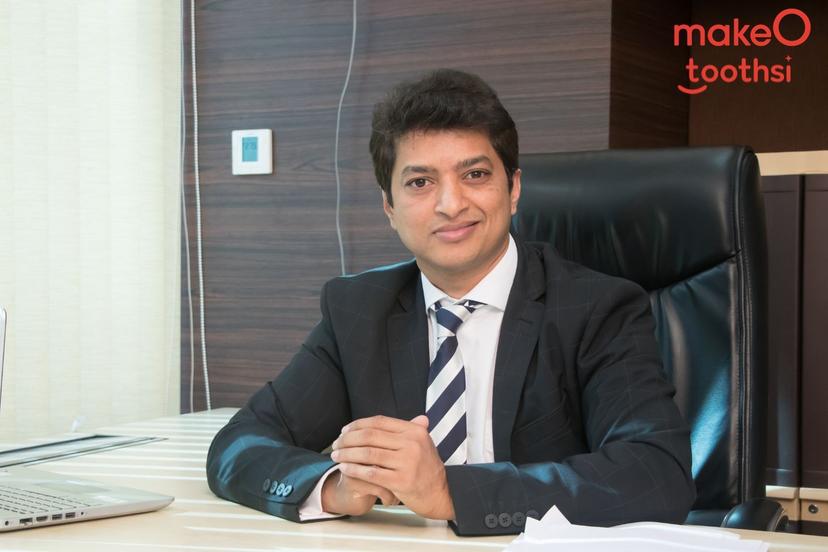MakeO blog
Dreaming of a straighter smile without compromising on appearance or hygiene? Clear aligners or braces that are invisible can be a fantastic option. While considering teeth straightening, it's natural to prioritise both aesthetic goals and exceptional oral hygiene. Unlike traditional braces, aligner therapy does not hinder your ability to practice oral hygiene, as the removable design allows for easy brushing and flossing. Plus, these are made of clear plastic, which is almost invisible, providing a discrete solution for individuals of all age groups.
In this article, we will discuss how clear aligners contribute to enhanced aesthetics and oral hygiene during and after your treatment. We will also guide you through some best practices for maintaining sparkling clean aligners, preventing unsightly stains, and ensuring a healthy mouth throughout your treatment journey. By following these tips, you can confidently achieve your dream smile while safeguarding your oral well-being.
Why Clear Aligners are a Game-Changer for Smile: Their Aesthetic Benefits
Clear aligners, an attractive and efficient way to straighten teeth, have completely changed orthodontics when it comes to maintaining your aesthetic goals. They address various teeth misalignment issues like crookedness, overcrowding, gaps, and bite problems, improving both appearance and function.
Aligners are made of clear plastic and are almost invisible, making them a top choice for teeth straightening by many. Traditional metal braces on the other hand have a stark appearance drawing all attention to your teeth. Even those with ceramic brackets make use of metallic wires which are quite visible. Thus, the cosmetic benefit aligners offer is particularly appealing for individuals who want to straighten their teeth discreetly.
Especially for adults, clear aligners provide an understated and practical orthodontic option. Their discreetness and removability minimize interruptions to social interactions and every-day activities by having minimal impact on appearance and enabling effortless eating, drinking, brushing, and flossing. Particularly individuals who value keeping their normal appearance and lifestyle while getting a straighter smile find this option very appealing3. Moreover, clear aligners show results comparable to traditional braces, sometimes even in a shorter time frame, allowing patients to achieve their aesthetic goals and a confident smile more quickly.
By prioritising aesthetics, clear aligners empower individuals to achieve their dental goals while maintaining their confidence throughout the treatment journey.
Oral Hygiene Challenges and Solutions with Clear Aligners
Effective dental hygiene might be seriously hampered by misaligned teeth. When teeth are arranged irregularly, there are many difficult-to-reach places where bacteria and food particles can readily become stuck. It is challenging for toothbrushes and floss to reach and completely clean these nooks and spaces between misaligned teeth thus affecting oral care. A higher risk of cavities, gum disease, and foul breath may result from this increased plaque accumulation.
Clear aligners are an effective solution for all types of teeth straightening including crowding, spacing, and bite issues. Having straighter teeth using clear aligners allows you to maintain good oral hygiene and lower your chances of developing dental problems in the future, keeping your oral health in good shape.
Although metal braces are also used for straightening teeth, they can cause problems with oral hygiene maintenance during treatment. Reaching every tooth surface with a toothbrush may become more challenging due to the brackets and wires of braces. Food particles may get stuck around the brackets, which raises the possibility of discoloration and plaque accumulation6. Clear aligners on the other hand serve as a modest approach for straightening teeth while maintaining good oral hygiene during the treatment.
Since aligners are removable, proper brushing and flossing can be done just as simply as before orthodontic treatment. This lowers the risk of cavities and gum disease and enables efficient plaque clearance. This helps prevent the development of dental issues like tooth decay or gum disease, which can hamper the treatment progress.
Moreover, not just oral hygiene, clear aligners are in general safer for your oral health. They considerably reduce the risk of injuries due to the treatment because of their smooth surface and rounded design. In contrast, metal braces have sharp edges with a tendency to scratch the inner lining of the mouth. This might increase the risk of cuts and wounds inside the mouth or on the lips and can cause discomfort and infection.
By far, clear aligners are an aesthetically pleasing and comfortable solution for teeth whitening while allowing you to maintain good oral hygiene during and after treatment. However, proper care is essential during clear aligner therapy to ensure that aligners are not damaged and remain stain-free to maintain effective treatment.
Effective Oral Care Tips While Wearing Clear Aligners
To ensure successful treatment and a healthy smile while wearing clear aligners, you must practice diligent oral hygiene. Here are some important tips:
Give importance to how to brush your teeth. Brush after each meal and snack to eliminate food particles that can get trapped under the aligners, causing plaque formation and perhaps discoloration.
Floss your teeth to remove food particles from in between your teeth, which your toothbrush cannot reach.
Always place aligners in their case when not in use. Proper storage of aligners is essential to prevent damage or contamination.
Limit your consumption of coffee, tea, red wine, and other staining chemicals.
Avoid sugary and sticky foods as these foods can increase the risk of cavities and plaque buildup.
Remove aligners before eating to allow for thorough cleaning of both the aligners and your teeth.
Drink enough water to stay hydrated. Hydration helps wash away food debris and promotes saliva production, which aids in fighting bacteria.
Avoid hard, crunchy foods as they may damage the aligners or cause them to break.
Consider using a water flosser, this can help remove plaque and food debris from areas that are difficult to reach with regular brushing and flossing.
Visit your dentist regularly. Regular dental examinations help monitor oral health and identify any concerns.
Understanding the potential problems and following adequate cleaning habits will help you navigate your aligner treatment journey with ease.
Conclusion
Clear aligners or invisible braces provide the perfect balance of comfort, aesthetics, and effectiveness. Because of their removability, they allow for better management of oral hygiene practices during treatment. They offer a discrete and comfortable teeth straightening solution for individuals of all age groups. While these invisible braces cost in India may be higher than metal braces, their convenience and flexibility make them a popular choice for many. Individuals who adhere to good oral hygiene practices, such as frequent brushing, flossing, and cleaning aligners for dental care, can effectively manage aligner therapy and achieve a confident, healthy smile.
Frequently Asked Questions
1. What kind of toothpaste should I use with clear aligners?
It is recommended to use fluoride toothpaste approved by the American Dental Association. Avoid whitening toothpaste, as it can cause uneven whitening while aligners are in use.
2. Can people with gum disease use clear aligners?
Yes, clear aligners are suitable for patients with gum disease if the condition is managed beforehand. They help maintain oral hygiene by making plaque control easier and promoting even stress distribution on teeth.
3. What tools can help keep my teeth clean with clear aligners?
Yes, tools like interproximal brushes, water irrigators, and fluoride mouth rinses can enhance oral hygiene by removing debris, flushing out particles, and strengthening enamel during treatment.
4. How can I stop my clear aligners from staining?
Avoid consuming staining foods and beverages like coffee or tea while wearing aligners and clean them promptly if exposed to such substances.
5. How often should I clean my aligner case?
Clean your aligner case daily with warm, soapy water to prevent bacterial buildup and contamination.
6. What happens if I forget to brush before putting my aligners back in?
Food particles left on teeth can lead to plaque buildup, bad breath, and an increased risk of cavities. Always brush and rinse before reinserting aligners.
7. Are clear aligners better for looks compared to braces?
Clear aligners are virtually invisible, allowing you to maintain your natural smile throughout treatment, which significantly boosts self-confidence as you won't feel self-conscious about your appearance during orthodontic treatment.
8. How do clear aligners improve oral hygiene?
The removable nature of aligners allows for thorough brushing and flossing, minimizing plaque buildup and reducing the risk of cavities and gum disease, while also making it easier to clean and maintain the straighter teeth achieved after treatment.
9. Can I still eat and drink normally with clear aligners?
While aligners offer the flexibility to eat and drink most foods, it is best to avoid sticky or hard substances like chewing gum, popcorn kernels, and hard candies, as they can damage the aligners.
10. How can I maintain good oral hygiene while wearing clear aligners?
Maintain optimal oral hygiene by brushing and flossing before and after replacing your aligners, rinsing them with cool water and gently brushing them with a soft-bristled toothbrush, soaking them in the prescribed cleaning solution, and scheduling regular checkups with your orthodontist to monitor progress and ensure proper oral hygiene.
related categories
Related articles

This Diwali, Smile Bright With makeO Teeth Whitening Kit

Types of Braces: Removable vs Fixed Braces, Which is Right For You?

Dr. Pravin Shetty: Pioneer in Lingual Orthodontics & Innovative Smile Solutions
How do I Know I’m the Right Candidate for makeO toothsi Teeth Aligners?

